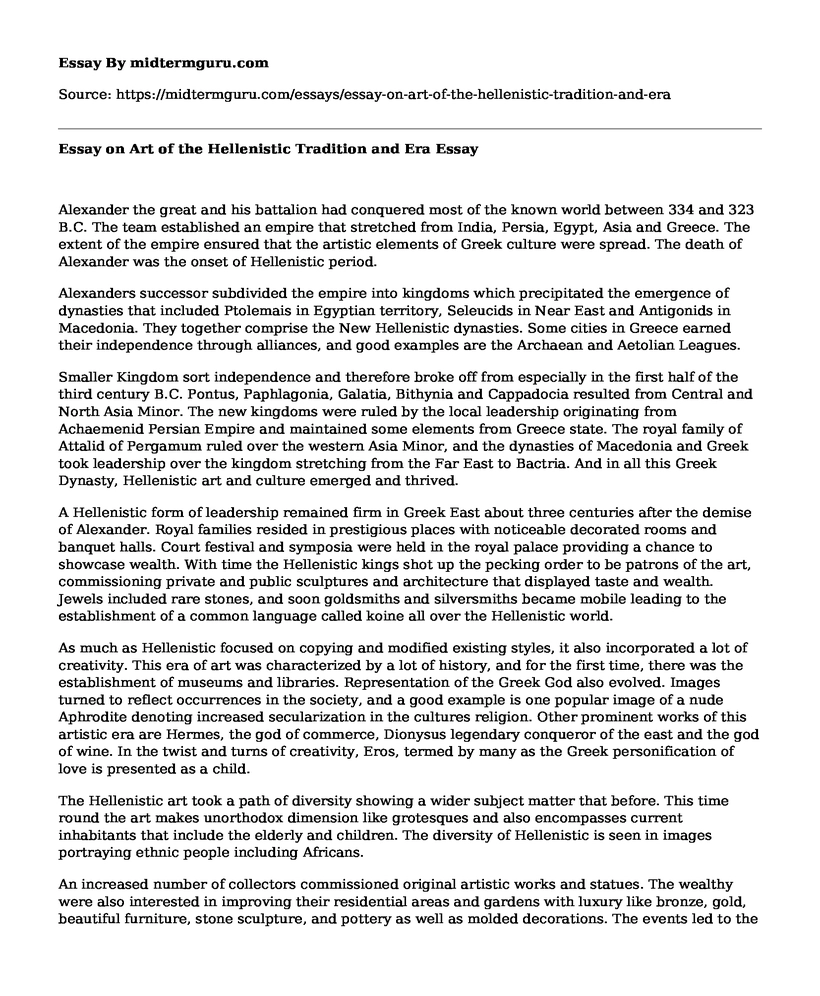Alexander the great and his battalion had conquered most of the known world between 334 and 323 B.C. The team established an empire that stretched from India, Persia, Egypt, Asia and Greece. The extent of the empire ensured that the artistic elements of Greek culture were spread. The death of Alexander was the onset of Hellenistic period.
Alexanders successor subdivided the empire into kingdoms which precipitated the emergence of dynasties that included Ptolemais in Egyptian territory, Seleucids in Near East and Antigonids in Macedonia. They together comprise the New Hellenistic dynasties. Some cities in Greece earned their independence through alliances, and good examples are the Archaean and Aetolian Leagues.
Smaller Kingdom sort independence and therefore broke off from especially in the first half of the third century B.C. Pontus, Paphlagonia, Galatia, Bithynia and Cappadocia resulted from Central and North Asia Minor. The new kingdoms were ruled by the local leadership originating from Achaemenid Persian Empire and maintained some elements from Greece state. The royal family of Attalid of Pergamum ruled over the western Asia Minor, and the dynasties of Macedonia and Greek took leadership over the kingdom stretching from the Far East to Bactria. And in all this Greek Dynasty, Hellenistic art and culture emerged and thrived.
A Hellenistic form of leadership remained firm in Greek East about three centuries after the demise of Alexander. Royal families resided in prestigious places with noticeable decorated rooms and banquet halls. Court festival and symposia were held in the royal palace providing a chance to showcase wealth. With time the Hellenistic kings shot up the pecking order to be patrons of the art, commissioning private and public sculptures and architecture that displayed taste and wealth. Jewels included rare stones, and soon goldsmiths and silversmiths became mobile leading to the establishment of a common language called koine all over the Hellenistic world.
As much as Hellenistic focused on copying and modified existing styles, it also incorporated a lot of creativity. This era of art was characterized by a lot of history, and for the first time, there was the establishment of museums and libraries. Representation of the Greek God also evolved. Images turned to reflect occurrences in the society, and a good example is one popular image of a nude Aphrodite denoting increased secularization in the cultures religion. Other prominent works of this artistic era are Hermes, the god of commerce, Dionysus legendary conqueror of the east and the god of wine. In the twist and turns of creativity, Eros, termed by many as the Greek personification of love is presented as a child.
The Hellenistic art took a path of diversity showing a wider subject matter that before. This time round the art makes unorthodox dimension like grotesques and also encompasses current inhabitants that include the elderly and children. The diversity of Hellenistic is seen in images portraying ethnic people including Africans.
An increased number of collectors commissioned original artistic works and statues. The wealthy were also interested in improving their residential areas and gardens with luxury like bronze, gold, beautiful furniture, stone sculpture, and pottery as well as molded decorations. The events led to the items being manufactured on a larger scale than in the previous eras.
Romans were known to collect Greek art to decorate their homes and villas. The wall painting at Boscoreale is a living testimony of Hellenistic Macedonian beautiful bronzes and royal paintings existing in Metropolitan Museum which broadcast the taste that Romans had developed for such art. At the time first century B.C was approaching Rome the work center for Hellenistic art production.
Fall of Hellenistic period happened in 31B.C when Octavian conquered Anthony Marc ending Ptolemaic rule and establishing Emperor Augustus era. The change in leadership wash away the artistic concept and centuries down the line; Roman artists make their work in respect to Hellenistic traditions.
Reference
1.Hemingway, A. S. (n.d.). Art of the Hellenistic Age and the Hellenistic Tradition | Essay | Heilbrunn Timeline of Art History | The Metropolitan Museum of Art. Retrieved February 16, 2017, from http://metmuseum.org/toah/hd/haht/hd_haht.htm.
2.Met Audio Guide Online. (n.d.). Retrieved February 16, 2017, from http://www.metmuseum.org/.
Cite this page
Essay on Art of the Hellenistic Tradition and Era. (2021, Jun 03). Retrieved from https://midtermguru.com/essays/essay-on-art-of-the-hellenistic-tradition-and-era
If you are the original author of this essay and no longer wish to have it published on the midtermguru.com website, please click below to request its removal:
- Essay Sample on John Muir: A Lifelong Romance With Nature
- The Role of Judiciary in War on Terror - Essay Sample
- Paper Example on Civil Rights in Black and Brown Project
- Essay Sample on Abraham Lincoln as a Reflection of Culture and the Time He Existed
- Just War and Jihad - Essay Sample
- Movie Analysis Essay on I Am Not Your Negro
- Japan's WWII Trauma: Psychological & Physical Scars - Essay Sample







